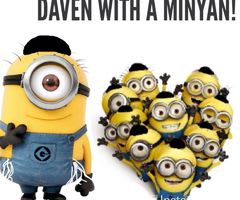The mishna at the very end of Rosh HaShana records a dispute between Rabban Gamliel and the Sages. The Sages state that the prayer leader (shaliach tzibur) can fulfill the prayer obligation only of those who are unfamiliar with the prayers. Those who are familiar with the prayers and are able to pray are obligated to say their own prayer. Rabban Gamliel asserts that even those who are familiar with the prayers can fulfill their obligation by listening carefully to the prayer of the prayer leader.
One explanation in the gemara states that all agree that on Rosh HaShana all can fulfill their obligation by listening to the shaliach tzibur; furthermore, even those “people in the fields” who can not make it to shul at all are exempted by the shaliach tzibur’s prayer. The reason is that these prayers are longer and many people are unfamiliar with them. Most Rishonim rule according to this explanation (see Tur OC 591).
One interesting point is that while those who can not make it to shul are exempted by the prayers of the prayer leader, they are only exempted if there are ten present. In other words, the shaliach tzibbur’s prayer is considered a prayer of the community as whole, and not only of those present; but this “communal prayer” only exists by virtue of the ten men who pray in shul.
This suggests that not only is the shaliach tzibur a representative of the community, but also those who make up the minyan are in some sense “shelichei tzibbur” – representatives of the community as a whole.
This inference from the passage in Rosh HaShana was made by the Chazon Ish (OC 19:3), who writes: “Every community (eida) is obligated to select ten from among them”. The mention of “eida” refers to the gemara which teaches that a minyan is required for sanctification of G-d’s name (through communal prayers, Torah reading and so on) because His name is sanctified in the eida, and an eida refers to at least ten men – as we learn from the ten spies who are referred to as a wicked eida (Megilla 23b).
The Chazon Ish implies that the requirement for ten does not mean that the ten constitute an eida, but rather that a quorum of ten is required in order to effectively represent an eida – which he construes to refer to a community.
Rav Yosef Dov Soloveitchik expresses a closely related opinion. In his view, the word eida does not refer to a particular community but rather to the entire Community of Israel. Fundamentally, a davar shebikedusha, which we have translated as public sanctifica- tion of G-d’s name, can be uttered only in the presence of the entire Jewish People. “His name can only be sanctified when the entire nation, the entire Congregation of Israel, sanctifies it; and only in the presence of all of them can the sanctification of His name take place… However, since practically speaking this is impossible to achieve in all generations, the law was established that the term eida can apply to any ten of Israel. And this can be inferred from the words of the Rambam: ‘For any ten of Israel are called eida’ – they are the emissaries and representatives of the entire Congregation of Israel” (Shiurim l’Zecher Abba Mari vol. II pg. 34).
This insight should inspire us all to have greater intensity in our prayers. Almost everyone prays with greater strength, intention and intensity when he is shaliach tzibur. If we keep in mind that every single shul-goer is likewise a shaliach tzibur of the entire community or indeed the entire Congregation of Israel, and remember that nowadays the majority of our neighbors are “people in the fields” who are unfamiliar with true Jewish prayer, we are certain to be strengthened in our individual prayers during the coming Days of Awe as well as all year round.
Rabbi Asher Meir is the author of the book Meaning in Mitzvot, distributed by Feldheim. The book provides insights into the inner meaning of our daily practices, following the order of the 221 chapters of the Kitzur Shulchan Aruch.
The words of this author reflect his/her own opinions and do not necessarily represent the official position of the Orthodox Union.

